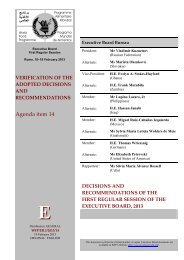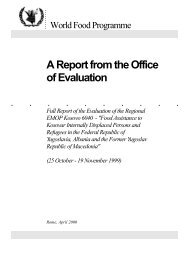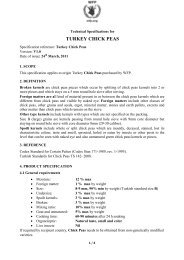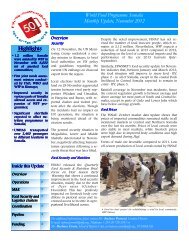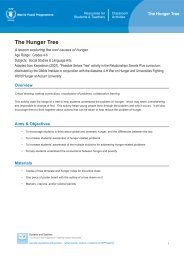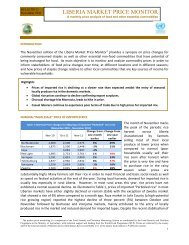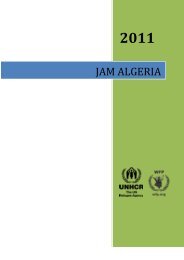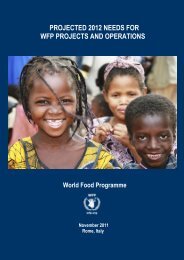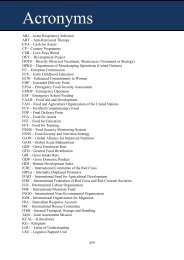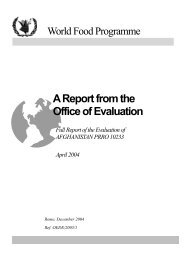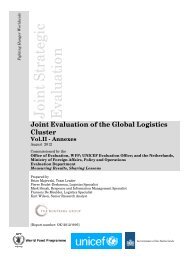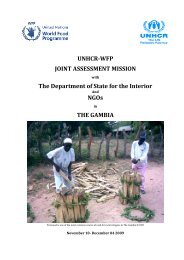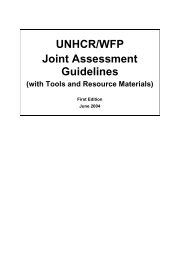The Potential for Scale and Sustainability in Weather Index Insurance
The Potential for Scale and Sustainability in Weather Index Insurance
The Potential for Scale and Sustainability in Weather Index Insurance
You also want an ePaper? Increase the reach of your titles
YUMPU automatically turns print PDFs into web optimized ePapers that Google loves.
THE POTENTIAL FOR SCALE AND SUSTAINABILITY IN WEATHER INDEX INSURANCE<br />
FOR AGRICULTURE AND RURAL LIVELIHOODS<br />
market. <strong>The</strong> <strong>in</strong>surance targeted a group of 5 million transiently food-<strong>in</strong>secure people who<br />
are directly affected <strong>in</strong> the case of drought. 18<br />
<strong>The</strong> Ethiopian Drought <strong>Index</strong> (EDI) was developed us<strong>in</strong>g historical data provided by the<br />
National Meteorological Agency (NMA), together with a crop water-balance model.<br />
Ra<strong>in</strong>fall was monitored at 26 weather stations <strong>in</strong>stalled across the country. <strong>The</strong> <strong>in</strong>dex had<br />
an 80 per cent correlation with the number of food aid recipients from 1994 to 2004, which<br />
demonstrated that it could act as a good <strong>in</strong>dicator of human need when drought strikes.<br />
Extension officers <strong>in</strong> the field reported that the <strong>in</strong>dex effectively tracked ra<strong>in</strong>. Axa Re<br />
re<strong>in</strong>sured the contract, with a premium set at US$0.93 million <strong>and</strong> a maximum payout of<br />
US$7.1 million <strong>in</strong> the event of severe drought.<br />
At the end of the coverage period <strong>in</strong> October 2006, the EDI was well below the<br />
US$55 million trigger level, as ra<strong>in</strong>fall was above normal that year; thus no payout was<br />
made. Despite this fact, the pilot demonstrated the feasibility of <strong>in</strong>dex <strong>in</strong>surance. It showed<br />
good capacity-build<strong>in</strong>g between the Government <strong>and</strong> local partners, <strong>in</strong>clud<strong>in</strong>g NMA, which<br />
was able to deliver quality data.<br />
<strong>The</strong> policy was not renewed <strong>in</strong> 2007 due to lack of donor support. However, other <strong>in</strong>dex<strong>in</strong>surance<br />
pilots did follow this <strong>in</strong>itiative. 19<br />
Box 1: LEAP software<br />
Follow<strong>in</strong>g the first <strong>in</strong>dex <strong>in</strong>surance pilot <strong>in</strong> Ethiopia, under the guidance of agronomist <strong>and</strong><br />
weather expert Peter Hoefsloot, WFP <strong>and</strong> the World Bank developed the Livelihoods, Early<br />
Assessment <strong>and</strong> Protection (LEAP) software application. Based on the Water Requirement<br />
Satisfaction <strong>Index</strong> (WRSI) of the Food <strong>and</strong> Agriculture Organization of the United Nations<br />
(FAO), the software allows users to quantify <strong>and</strong> <strong>in</strong>dex the drought <strong>and</strong> excessive ra<strong>in</strong>fall risk<br />
<strong>in</strong> a particular adm<strong>in</strong>istrative unit. <strong>The</strong> software monitors this risk <strong>and</strong> guides disbursements<br />
<strong>for</strong> the scal<strong>in</strong>g up of the Ethiopian Productive Safety Net Programme (PSNP), a Government<br />
programme that targets the poorest people fac<strong>in</strong>g food <strong>in</strong>security <strong>in</strong> any type of weather.<br />
LEAP runs localized models to convert ra<strong>in</strong>fall data <strong>in</strong>to crop or rangel<strong>and</strong> production<br />
estimates <strong>and</strong> subsequently <strong>in</strong>to livelihood stress <strong>in</strong>dicators <strong>for</strong> vulnerable populations. It uses<br />
ground <strong>and</strong> satellite ra<strong>in</strong>fall data to map the whole of Ethiopia, <strong>and</strong> it is able to cover areas<br />
without weather stations, so that all adm<strong>in</strong>istrative units <strong>in</strong> the country can be <strong>in</strong>cluded. LEAP<br />
then estimates the f<strong>in</strong>ancial magnitude of the livelihood-sav<strong>in</strong>g <strong>in</strong>terventions needed <strong>in</strong> the<br />
event of a weather shock. It thus provides a good estimate of the fund<strong>in</strong>g needed to protect<br />
transiently food-<strong>in</strong>secure people’s livelihoods at a time of shock – <strong>and</strong> it does so through an<br />
<strong>in</strong>dependent, objective, verifiable <strong>and</strong> replicable <strong>in</strong>dex of livelihood stress.<br />
18 ‘Transiently food-<strong>in</strong>secure’ describes people that are usually not food <strong>in</strong>secure (i.e. <strong>in</strong> favourable weather<br />
conditions). However, they are likely to become food <strong>in</strong>secure <strong>in</strong> the case of drought or floods. <strong>The</strong>y are not part<br />
of the Productive Safety Net Programme (PSNP) ‘regular’ or chronic beneficiary caseload. <strong>The</strong> idea is to prevent<br />
them from becom<strong>in</strong>g chronically food <strong>in</strong>secure.<br />
19 Ulrich Hess <strong>and</strong> Laura Verlangieri, Disaster <strong>in</strong>surance <strong>in</strong> Ethiopia, <strong>in</strong> <strong>Index</strong> <strong>in</strong>surance <strong>and</strong> climate risk: Prospects<br />
<strong>for</strong> development <strong>and</strong> disaster management, ed. M.E. Hellmuth, D.E. Osgood, U. Hess, A. Moorhead <strong>and</strong> H.<br />
Bhojwani. Climate <strong>and</strong> Society No. 2 (New York: International Research Institute <strong>for</strong> Climate <strong>and</strong> Society (IRI),<br />
Columbia University, 2009).<br />
ANNEX<br />
87



